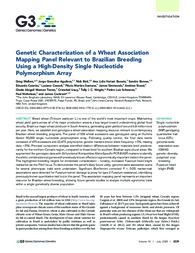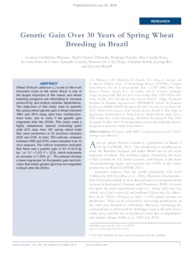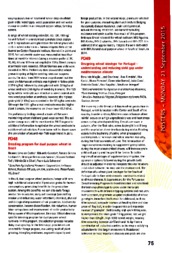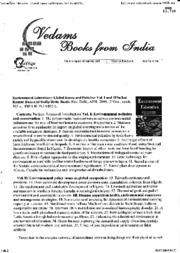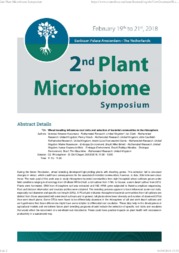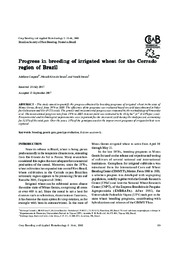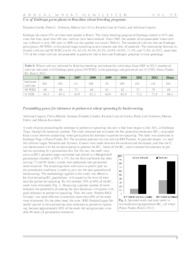Busca de Publicações
Filtrar por:
| Autoria: Mellers, G.; Aguilera, J. G.; Bird, N.; BONATO, A. L. V.; BONOW, S.; CAIERAO, E.; CONSOLI, L.; SANTANA, F. M.; Simmonds, J.; Steed, A.; TORRES, G. A. M.; Uauy, C.; Wright, T. I. C.; SCHEEREN, P. L.; Nicholson, P.; Cockram, J. ABSTRACT Bread wheat (Triticum aestivum L.) is one of the world?s most important crops. Maintaining wheat yield gains across all of its major production areas is a key target toward underpinning globa... ... |
| Autoria: WOYANN, L. G.; ZDZIARSKI, A. D.; ZANELLA, R.; ROSA, A. C.; CASTRO, R. L. de; CAIERÃO, E.; TOIGO, M. D.; STORCK, L.; WU, J.; BENIN, G.
|
| |
| Autoria: CHAVES, M. S.; MARTINELLI, J. A.; SCAGLIUSI, S. M. M.; BRAMMER, S. P.
|
| Autoria: BRAMMER, S. P.; CARGNIN, A.; KIIHL, T. A. M.; RESENDE, T. T. de; CASASSOLA, A.; CECCON, C. C. Synthetic hexaploid wheat (AABBDD) is produced by using the tetraploid Triticum turgidum var. durum (AABB) and the diploid Aegilops tauschii (DD) as parents. This cross has allowed genetic variability... ... |
| Autoria: KAVAMURA, V. N.; CLARK, I.; HIRSCH, P. R.; CAULFIELD, J.; SARRIA, A. F.; ROSSMANN, M.; BIRKETT, M.; MELO, I. S. de; MENDES, R.; MAUCHLINE, T. During the Green Revolution, wheat breeding developed high-yielding plants with dwarfing genes. This selection led to structural changes in wheat, which could have consequences for the associated micr... ... |
| Autoria: CARGNIN, A.; SOUZA, M. A. de; FRONZA, V. This study aimed to quantify the progress obtained by breeding programs of irrigated wheat in the state of Minas Gerais, Brazil, from 1976 to 2005. The efficiency of the programs was evaluated based o... ... |
| |
| Autoria: CHAVES, M. S.; SILVA, G. B. da; CAIERAO, E.; FEDERIZZI, L. C.; MARTINELLI, J. A. Abstract: Wheat breeding in Brazil began in 1919. A cross between the varieties Fronteira and Mentana gave rise to Frontana, the most popular ever released, being recommended for more than 40 years. F... ... |
| Autoria: FRIZON, P.; BRAMMER, S. P.; LIMA, M. I. P. M.; CASTRO, R. L. de; DEUNER, C. C.
|
Observações
1 - Por padrão são exibidas publicações dos últimos 20 anos. Para encontrar publicações mais antigas, configure o filtro ano de publicação, colocando o ano a partir do qual você deseja encontrar publicações. O filtro está na coluna da esquerda na busca acima.
2 - Para ler algumas publicações da Embrapa (apenas as que estão em formato ePub), é necessário ter, no celular ou computador, um desses softwares gratuitos. Sistemas Android: Google Play Livros; IOS: iBooks; Windows e Linux: software Calibre.
Acesse outras publicações
Acesse a Base de Dados da Pesquisa Agropecuária (BDPA) para consultar o acervo completo das bibliotecas da Embrapa.

